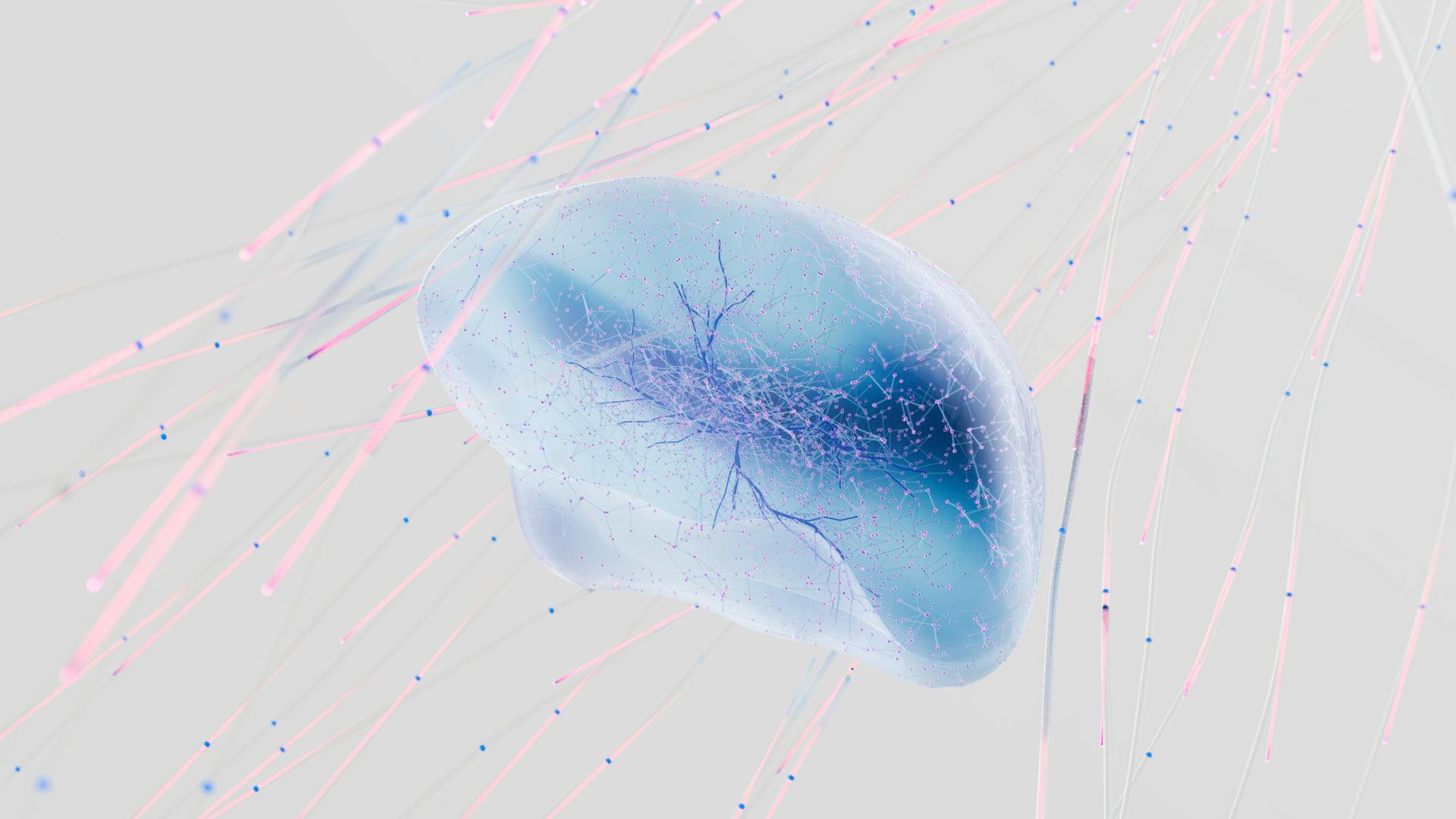
Machine learning has come a long way since its inception, and learning systems have played a crucial role in its development. The concept of learning systems dates back to the 1950s with the development of the first neural networks by Warren McCulloch and Walter Pitts.
These early neural networks were inspired by the human brain's ability to learn and adapt, and they paved the way for the creation of more complex learning systems. In the 1980s, David Rumelhart, Geoffrey Hinton, and Yann LeCun developed the backpropagation algorithm, which is still a fundamental component of many machine learning models today.
The backpropagation algorithm allowed for the efficient training of multi-layer neural networks, which are capable of learning complex patterns in data. This breakthrough led to the development of more sophisticated learning systems, such as support vector machines and decision trees.
See what others are reading: Hidden Layers in Neural Networks Code Examples Tensorflow
History of Learning Systems
The history of learning systems in machine learning dates back to the 1940s with Canadian psychologist Donald Hebb's book The Organization of Behavior, which introduced a theoretical neural structure formed by certain interactions among nerve cells.
This groundwork laid the foundation for how AIs and machine learning algorithms work under nodes, or artificial neurons used by computers to communicate data.
In the 1950s, Arthur Samuel invented a program that calculated the winning chance in checkers for each side, marking the earliest machine learning model.
Arthur Samuel coined the term machine learning in 1959, and the synonym self-teaching computers was also used during this time period.
The first experimental "learning machine" was developed by Raytheon Company in the early 1960s, which analyzed sonar signals, electrocardiograms, and speech patterns using rudimentary reinforcement learning.
This learning machine was repetitively "trained" by a human operator/teacher to recognize patterns and equipped with a "goof" button to cause it to reevaluate incorrect decisions.
Tom M. Mitchell provided a widely quoted definition of machine learning in 1997, stating that "A computer program is said to learn from experience E with respect to some class of tasks T and performance measure P if its performance at tasks in T, as measured by P, improves with experience E."
Modern-day machine learning has two main objectives: classifying data based on developed models and making predictions for future outcomes based on these models.
Recommended read: Energy Based Model
Artificial Intelligence and Machine Learning
Artificial intelligence grew out of the quest for machine learning, which was initially approached with symbolic methods and neural networks.
Probabilistic reasoning was also employed, especially in automated medical diagnosis, but it was plagued by theoretical and practical problems of data acquisition and representation.
Machine learning started to flourish in the 1990s, shifting its focus away from symbolic approaches and toward methods and models borrowed from statistics, fuzzy logic, and probability theory.
Recommended read: Proximal Gradient Methods for Learning
What Is a Machine System?
A Machine Learning System is a concrete implementation of all activities and their artifacts that deliver value to a customer using a Machine Learning approach.
It's a complex process that involves several key components, including data collection, experimentation, deployment, and operations. Data collection is crucial, as we need to create datasets and keep them up to date.
The quality of our data is also essential, and we need to consider factors like data quality, label quality and availability, dataset size, and data domain variability.
Here are some key activities that are part of a Machine Learning System:
- Data Collection — we create datasets and keep them up to date.
- Experimentation — we explore our data, formulate and validate different hypotheses about the data and models, and construct training and prediction pipelines.
- Deployment — we integrate our result pipeline into a working product.
- Operations — we monitor the running model keeping it up to date with a constantly changing environment.
We also need to consider the problem domain, project time and other resources limitations, and the structure of our company when implementing a Machine Learning System.
Machine Learning
Machine learning grew out of the quest for artificial intelligence, with researchers initially trying to approach the problem with symbolic methods and neural networks.
By the 1980s, expert systems had dominated AI, and statistics was out of favor, causing a rift between AI and machine learning.
The more statistical line of research was continued outside the AI/CS field, where it was known as "connectionism", by researchers from other disciplines.
Machine learning started to flourish in the 1990s, shifting its focus away from symbolic approaches and toward methods and models borrowed from statistics, fuzzy logic, and probability theory.
The field changed its goal from achieving artificial intelligence to tackling solvable problems of a practical nature.
If this caught your attention, see: Glossary of Artificial Intelligence
Machine learning finds generalizable predictive patterns, whereas statistics draws population inferences from a sample.
The more variables used to train a machine learning model, the more accurate the ultimate model will be.
Machine learning is not built on a pre-structured model; rather, the data shape the model by detecting underlying patterns.
Some statisticians have adopted methods from machine learning, leading to a combined field that they call statistical learning.
Statistical Physics
Statistical physics is being applied to machine learning to analyze the weight space of deep neural networks.
This is made possible by extending analytical and computational techniques derived from the physics of disordered systems to large-scale problems.
Statistical physics can be used to analyze the weight space of deep neural networks.
This has real-world applications, such as in medical diagnostics.
The techniques derived from statistical physics can help identify patterns and relationships in complex data sets.
This can lead to more accurate diagnoses and better treatment outcomes.
If this caught your attention, see: Applied Machine Learning Explainability Techniques
Supervised
Supervised learning is a type of machine learning where the algorithm learns from labeled data. This means that the data is already pre-classified, and the algorithm's goal is to learn from it to make accurate predictions.
In supervised learning, the data is represented by a matrix, with each row being a training example and each column being a feature. The algorithm learns a function that can be used to predict the output associated with new inputs.
Supervised learning algorithms can be used for classification, regression, or similarity learning. Classification algorithms are used when the outputs are restricted to a limited set of values, and regression algorithms are used when the outputs may have any numerical value within a range.
Here are some common types of supervised learning algorithms:
- Regression Analysis
- Linear Regression
- Simple Linear Regression
- Multiple Linear Regression
- Backward Elimination
- Polynomial Regression
These algorithms can be used for tasks such as predicting the height of a person or the future temperature, or classifying emails into folders. The goal is to learn a function that can be used to make accurate predictions, and the algorithm improves its accuracy over time as it learns from the data.
Learning System Fundamentals
Machine learning algorithms are not a silver bullet. They require careful design and can be susceptible to human error and biases.
Developing machine learning systems is not unlike writing software code - it needs to be designed with precision and attention to detail. This is why machine learning algorithms are not a quick fix, but rather a tool that requires skill and expertise to use effectively.
DOE-funded researchers have used machine learning to develop new cancer screening and better understand the properties of water, among other applications. This shows the potential of machine learning to solve complex scientific problems.
Here are some key characteristics of machine learning algorithms:
- Machine learning allows scientists to analyze quantities of data that were previously inaccessible.
- Physics-informed machine learning uses deep neural networks that can be trained to incorporate specific laws of physics to solve supervised learning tasks and scientific problems.
Statistics
Machine learning and statistics are closely related fields, but they have distinct goals. Statistics draws population inferences from a sample, while machine learning finds generalizable predictive patterns.
According to Michael I. Jordan, machine learning has a long pre-history in statistics, with many methodological principles and theoretical tools being borrowed from the field. This means that statisticians and machine learning practitioners often work together, combining their expertise to create more effective models.
Machine learning models are not built on a pre-structured model, unlike conventional statistical analyses. Instead, the data shape the model by detecting underlying patterns, making it more accurate and flexible. The more variables (input) used to train the model, the more accurate the ultimate model will be.
Machine learning algorithms, such as Random Forest, are a type of algorithmic model that can be used for statistical analysis. These algorithms are particularly useful for handling large datasets and finding complex patterns.
Here are some key differences between statistical and machine learning approaches:
- Statistics: draws population inferences from a sample
- Machine learning: finds generalizable predictive patterns
- Statistics: requires a priori selection of a model
- Machine learning: allows the data to shape the model
By understanding the strengths and weaknesses of both statistical and machine learning approaches, practitioners can choose the best tools for their project and create more effective models.
A Model Reflects Its Training Data
Data plays a significant role in the quality of the learned algorithm, and it's the uniqueness of your product. The code of the model can be standardized and extracted into reusable libraries, but the data represents what makes your product unique.
Machine learning models are a type of mathematical model that can be used to make predictions or classifications on new data. During training, a learning algorithm iteratively adjusts the model's internal parameters to minimize errors in its predictions.
A high quantity of reliable data is typically required to perform accurate predictions, and machine learning engineers need to target and collect a large and representative sample of data. Overfitting is something to watch out for when training a machine learning model, as it can result in skewed or undesired predictions.
Curious to learn more? Check out: Transfer Learning Enables Predictions in Network Biology
Criterion of Optimality
A learning system's ability to make optimal decisions depends on its ability to evaluate options and choose the best one. This is where the criterion of optimality comes in.
The criterion of optimality is a standard or benchmark that a learning system uses to determine whether its decisions are good or bad. It's like having a yardstick to measure progress.
Readers also liked: Automated Decisions
In a learning system, the criterion of optimality is often based on a reward function, which assigns a score to each possible action. The action with the highest reward is considered the optimal choice.
A well-designed reward function can make a big difference in a learning system's performance. For example, if a system is designed to play a game, the reward function might assign a high score for winning and a low score for losing.
The criterion of optimality helps a learning system to learn from its mistakes and improve over time. By evaluating its decisions and adjusting its strategy accordingly, the system can become more effective and efficient.
In a learning system, the criterion of optimality is not a fixed target, but rather a dynamic goal that adapts to changing circumstances. This allows the system to respond to new information and unexpected events.
You might like: Inception Score
Learning System Approaches
Learning system approaches are traditionally divided into three broad categories: supervised learning, unsupervised learning, and reinforcement learning. Supervised learning involves the computer being presented with example inputs and their desired outputs, given by a "teacher", to learn a general rule that maps inputs to outputs.
Take a look at this: Supervised or Unsupervised Machine Learning Examples
In unsupervised learning, no labels are given to the learning algorithm, leaving it to find structure in its input. This can be a goal in itself, such as discovering hidden patterns in data, or a means towards an end, like feature learning.
Reinforcement learning, on the other hand, is an area of machine learning concerned with how software agents ought to take actions in an environment so as to maximize some notion of cumulative reward. This approach is used when exact models are infeasible.
Here are the three learning system approaches summarized:
- Supervised learning: learns from labeled data to map inputs to outputs
- Unsupervised learning: finds structure in data without labels
- Reinforcement learning: learns through rewards and feedback to maximize cumulative reward
Approaches
Machine learning approaches are traditionally divided into three broad categories: supervised learning, unsupervised learning, and reinforcement learning. Each has its own strengths and weaknesses.
Supervised learning presents the computer with example inputs and their desired outputs, allowing it to learn a general rule that maps inputs to outputs. This approach is useful for tasks like image classification and natural language processing.
For more insights, see: Difference between Supervised and Unsupervised Machine Learning
Unsupervised learning, on the other hand, leaves the learning algorithm on its own to find structure in its input, without any labels or guidance. This can be a goal in itself, helping to discover hidden patterns in data, or a means towards an end, like feature learning.
Reinforcement learning involves a computer program interacting with a dynamic environment, where it must perform a certain goal, such as driving a vehicle or playing a game against an opponent. As it navigates its problem space, the program is provided feedback that's analogous to rewards, which it tries to maximize.
Here are the three main machine learning approaches, summarized:
Self
Self-learning systems are a type of machine learning paradigm that allows agents to learn from their environment without external rewards or advice. Introduced in 1982, self-learning is a key concept in understanding how machines can adapt and improve their behavior over time.
The Crossbar Adaptive Array (CAA) is a neural network capable of self-learning, which computes decisions about actions and emotions about consequence situations in a crossbar fashion. This system is driven by the interaction between cognition and emotion.
In self-learning, the algorithm updates a memory matrix W =||w(a,s)||, which includes the following machine learning routine: perform action a, receive consequence situation s', compute emotion v(s'), and update crossbar memory w'(a,s) = w(a,s) + v(s'). This process is repeated in each iteration, allowing the system to learn from its experiences.
The CAA exists in two environments: the behavioral environment, where it behaves, and the genetic environment, where it receives initial emotions about situations to be encountered in the behavioral environment. The genetic environment provides the initial emotions, which are used to learn a goal-seeking behavior in the behavioral environment.
Here's a summary of the self-learning algorithm:
Self-reinforcement learning is another type of self-learning paradigm that uses internal self-reinforcement, provided by feelings and emotions, instead of external rewards. The learning equation does not include immediate rewards, but rather state evaluations.
The Crossbar Adaptive Array (CAA) is also capable of self-reinforcement learning, which was introduced in 1982. This system computes both decisions about actions and emotions about consequence states in a crossbar fashion, driven by the interaction between cognition and emotion.
A unique perspective: Andrew Ng Reinforcement Learning
Policy
In a learning system, the policy is a crucial component that determines the agent's action selection.
The policy is modeled as a map that gives the probability of taking action a when in state s. This map is called the policy map.
Deterministic policies also exist, where the agent takes a specific action in a given state.
The policy map is a fundamental concept in learning systems, and it plays a key role in decision-making processes.
Discover more: Action Model Learning
Frequently Asked Questions
What are the four types of machine learning systems?
There are four main types of machine learning systems: Supervised Learning, Unsupervised Learning, Semi-Supervised Learning, and Reinforcement Learning. Each type uses different approaches to enable machines to learn and make decisions, with unique applications and benefits.
Sources
- https://en.wikipedia.org/wiki/Machine_learning
- https://en.wikipedia.org/wiki/Reinforcement_learning
- https://www.energy.gov/science/doe-explainsmachine-learning
- https://towardsdatascience.com/machine-learning-systems-versus-machine-learning-models-3955d038ea1f
- https://www.javatpoint.com/designing-a-learning-system-in-machine-learning
Featured Images: pexels.com


